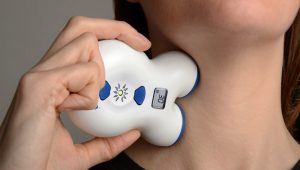Vagus nerve stimulation (VNS) is effective for the acute treatment of migraine attacks in episodic migraine, a randomised controlled trial has shown.
When compared against sham treatment in 248 people with episodic migraine with/without aura the VNS device (GammaCore) was superior in aborting migraine attacks at 30 and 60 minutes and also provided pain relief at 120 minutes, results from a multicentre trial conducted in Italy have shown.
In the study, designed according to International Headache Society guidelines, rates of freedom from pain were significantly greater for VNS than sham at 30 minutes (12.7% vs 4.2%), 60 minutes (21% vs 10%) but not at 120 minutes (30.4% vs 19.7%) among patients who received blinded treatment after the first attack.
The benefits on pain levels and relief of attacks seen in the initial double blind phase of the trial were maintained in a four week open continuation phase of the trial.

GammaCore device
The average pain-free response achieved at two hours (30%) with VNS was similar to that achieved with triptans and strong NSAIDs, according to the study authors led by Dr Cristina Tassorelli of the Headache Science Centre at the University of Pavia.
Published in Neurology, the authors said the findings showed VNS offered non-invasive treatment alternative to drug treatment for patients with migraine, which also had the advantage of having a good side-effect profile.
The mechanism of action of vagus nerve stimulation on migraine was not certain, but might involve central inhibition of the trigeminalovascular system and suppression of nociceptive activation, they suggested.
“Taken together, findings of this large, rigorous, well-controlled trial strongly suggest that non-invasive VNS is effective and has benefits consistent with standard drug options but with the added benefit of an extremely benign adverse effect profile and the flexibility to be used for multiple attacks without the risk of medication overuse or drug-related adverse effects.
“As a nonpharmacologic option, non-invasive VNS can also be utilised in combination with any existing medication,” they concluded.
Their recommendation was supported by neurologists Professor Peter Goadsby of London and Professor Richard Lipton of New York, who wrote in an accompanying commentary that the benefits of vagus nerve stimulation mirrored those of FDA-approved non-invasive neurostimulation techniques such as single-pulse transcranial magnetic stimulation (sTMS) and transcutaneous supraorbital nerve stimulation (tSNS).
“Given their availability, efficacy, and safety, coupled with their relative ease of use, neurostimulation should play an expanded role in general neurology practice,” they wrote.
“These approaches are particularly useful in patients who prefer nonpharmacologic options, in those with medication overuse, and in those who do not respond to or have side effects from pharmacotherapy. They are often a useful adjunct to pharmacotherapy,” they added.
However access to neurostimulation techniques may be limited by lack of reimbursement, the commentary noted.